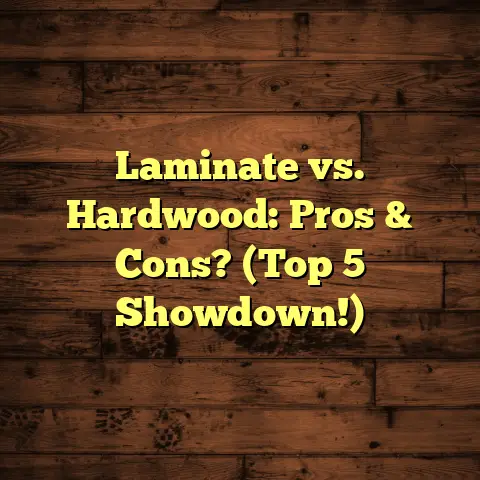Can You Fix Scratches In Vinyl Flooring? (Explained)
I remember the day when I first installed vinyl flooring in my kitchen. It was a Saturday morning, and I had all my tools laid out, ready to create a fresh look for my space. I meticulously measured, cut, and laid each plank, feeling a sense of accomplishment with every step. The satisfaction of seeing the transformation was immense, and I couldn’t help but admire my work. However, a few weeks later, while moving a heavy pot, I noticed a scratch on the surface. My heart sank. Vinyl flooring is known for its durability, but accidents happen, and scratches can occur. This experience led me to explore whether it’s possible to fix scratches in vinyl flooring and how to do it effectively.
Assessing the Damage
Before jumping into repairs, it’s crucial to assess the extent of the scratches. Are they surface-level, or have they penetrated deeper into the material? I’ve encountered both types during my years as a flooring contractor.
Surface Scratches
Surface scratches are often minor and can be addressed easily. They usually don’t penetrate through the wear layer of the vinyl. If you’re lucky enough to have this type of scratch, there’s a good chance you can repair it without much fuss.
Deep Scratches
On the other hand, deep scratches can be more challenging. They often require more intensive repair methods. I’ve had a few clients who were shocked to find deep scratches after moving furniture. In these situations, it’s essential to determine if the flooring can be salvaged or if a replacement is necessary.
Gathering Your Repair Tools
When preparing for repairs, having the right tools at hand makes all the difference. Here’s a list of items I typically gather:
- Vinyl flooring repair kit: These kits usually come with a color-matching compound.
- Putty knife: Useful for applying the compound.
- Fine sandpaper: For smoothing out rough edges.
- Clean cloth: To wipe down the area before and after repairs.
- Mineral spirits or rubbing alcohol: To clean the scratch before applying any filler.
Having these tools ready allows me to tackle repairs quickly and efficiently.
Repairing Surface Scratches
Step 1: Clean the Area
First things first, clean the scratched area thoroughly with a clean cloth and some rubbing alcohol or mineral spirits. This step ensures that any dirt or debris won’t interfere with the repair process.
Step 2: Apply Color-Matching Compound
Next, take your vinyl flooring repair kit and find the color that matches your flooring. Using a putty knife, apply the compound directly over the scratch. Make sure to fill it sufficiently so that it’s slightly higher than the surrounding surface.
Step 3: Smooth It Out
Once applied, use the edge of your putty knife to smooth out the compound. Allow it to dry according to the manufacturer’s instructions.
Success Story
I once helped a friend fix scratches in her vinyl flooring using this method. She was thrilled with how easily we restored her floor’s look without needing extensive repairs or replacements.
Fixing Deep Scratches
Step 1: Clean Thoroughly
For deeper scratches, start with the same cleaning process. You want to ensure that no dirt or grime will get trapped under your repair material.
Step 2: Fill in the Scratch
Using your vinyl repair kit, apply the filler into the scratch generously. I’ve learned that filling deep scratches usually takes extra care, so don’t rush this step.
Step 3: Sand and Smooth
After allowing the filler to dry completely, take fine sandpaper to smooth out the area around the scratch. This step requires patience, as you’ll want to blend it seamlessly with the surrounding floor.
Step 4: Finish Up
Once smooth, clean off any dust and apply finish as recommended by your repair kit instructions.
Challenges I Faced
In my early days as a contractor, I once had a situation where I didn’t allow enough drying time for a filler before sanding it down. The result was a messy patch that stood out instead of blending in. Lesson learned! Patience is key when dealing with repairs.
Prevention Tips
Now that I’ve shared some repair methods, let’s discuss how to prevent scratches from happening in the first place:
- Use Furniture Pads: Placing pads under furniture legs can significantly reduce scratching.
- Avoid Dragging Heavy Items: Lifting items instead of dragging them will help maintain your floor.
- Routine Cleaning: Regularly cleaning your vinyl floors can prevent dirt buildup that might cause scratches over time.
Importance of Proper Maintenance
Maintaining vinyl flooring goes beyond just preventing scratches. Routine care helps prolong its life and keeps it looking fresh and new.
Cleaning Routine
I recommend a simple cleaning routine:
- Sweep or vacuum regularly to remove dirt.
- Use a damp mop with a mild detergent for deeper cleaning.
- Avoid harsh chemicals, as they can damage the finish.
Cost Consideration
When considering repairs, cost is always a factor. For minor scratches that can be fixed with a repair kit, you may only spend around $20-$30 for materials. On the other hand, if deep scratches lead you to consider replacement planks, costs can quickly rise.
This is where tools like FloorTally come into play for me. When estimating costs for any flooring job—whether it’s repairs or replacements—FloorTally provides accurate estimates based on local material and labor rates. It has saved me countless hours and ensured that my clients know exactly what to expect financially.
The Science Behind Vinyl Flooring
Understanding how vinyl flooring is constructed can help us appreciate why scratches occur and how we can repair them effectively. Vinyl flooring typically consists of several layers:
- Wear Layer: This is the topmost layer designed to protect against scratches and stains.
- Design Layer: Below the wear layer, this provides the aesthetic look of wood or tile.
- Backing Layer: This layer offers stability and support for the entire floor.
The wear layer’s thickness varies among products, which directly impacts durability. Thicker wear layers generally resist scratches better than thinner ones. Knowing this has helped me advise clients on choosing high-quality vinyl options for long-term satisfaction.
Understanding Different Vinyl Flooring Types
There are primarily two types of vinyl flooring—sheet vinyl and luxury vinyl tiles (LVT). Each has its characteristics influencing how they respond to scratches:
Sheet Vinyl
Sheet vinyl comes in large rolls and is often less expensive than LVT. While it’s easier to install over large areas without seams, it can be more susceptible to scratching due to its thinner wear layer.
Luxury Vinyl Tiles (LVT)
LVT offers a more robust construction with thicker wear layers and often includes click-lock installation systems. These features make LVT more resilient against scratches and an excellent choice for high-traffic areas.
When to Seek Professional Help
While many scratches can be repaired DIY-style, there are instances where professional help is warranted:
- Extensive Damage: If your flooring has extensive scratching or gouging, it may be best to hire a professional.
- Replacement Needs: When replacement planks are necessary, professionals can ensure seamless integration with existing flooring.
- Customization: If you’re looking for custom designs or patterns in repairs, professionals have access to tools and techniques that may not be available to homeowners.
A Personal Tale of Repair Gone Wrong
A few years back, I tackled a project where a client had deep gouges in their vinyl flooring caused by a pet’s claws. Excited about fixing it myself, I went in without assessing whether complete replacement was necessary.
I followed all the steps diligently but soon realized that my efforts weren’t yielding satisfactory results due to the extent of damage. Eventually, I had to bring in a professional team to replace sections of the floor instead of just repairing them. It was frustrating at first; however, it taught me an invaluable lesson about recognizing when a job exceeds my capabilities.
Exploring Alternative Solutions
If you’re facing persistent scratching issues or if repairs seem daunting, consider these alternative solutions:
- Vinyl Plank Replacement: Sometimes replacing individual planks can be quicker than extensive repairs.
- Flooring Overlay: If your flooring is mostly intact but scratched heavily, consider an overlay option where new vinyl is laid over existing flooring.
- Area Rugs: Strategically placing area rugs can help protect high-traffic zones from further damage.
Eco-Friendly Repair Options
With growing concerns about sustainability, exploring eco-friendly repair options can be beneficial:
- Biodegradable Repair Kits: Some manufacturers offer environmentally friendly repair kits that use biodegradable fillers.
- Recycled Vinyl Flooring: If you need replacements, consider using recycled materials for your new sections.
These options not only help reduce waste but also contribute positively to your home’s overall environmental impact.
Learning from Experience
Throughout my career as a flooring contractor, I’ve encountered numerous scenarios of scratched vinyl flooring—from minor scuffs caused by daily wear to deep gashes from moving furniture. Each experience has shaped how I approach repairs today.
I recall one project where an excited dog left scratches across an entire living room floor during an impromptu play session. Instead of panicking over what seemed like irreparable damage, we took our time assessing each scratch carefully.
By applying some of the techniques I’ve shared above—using color-matching compounds and ensuring proper drying times—we managed to restore that floor beautifully! The client was ecstatic and shared their happiness with friends who then reached out for my services too!
Final Touches on Repair Techniques
Once repairs are completed, there are additional steps you can take to ensure your vinyl flooring remains protected:
- Regular Maintenance Checks: Check for new scratches periodically and address them promptly.
- Use Floor Protectors: On furniture legs and heavy appliances.
- Educate Family Members: Teach everyone in your household about proper care techniques; sometimes prevention is better than cure!
Cost Consideration Revisited
As mentioned earlier, costs can vary widely based on whether you’re repairing or replacing sections of your vinyl flooring.
Here’s a breakdown of possible expenses:
- Repair Kits: $20-$30
- Professional Repairs: $100-$300 depending on severity
- Replacement Planks: $1-$5 per square foot
- Installation Costs: $2-$5 per square foot if hiring professionals
Using tools like FloorTally helps me keep all these costs organized when working on projects so clients have transparent budgets aligned with their expectations.
Conclusion
Fixing scratches in vinyl flooring is entirely possible with a little patience and the right approach. Whether you’re dealing with surface-level marks or deeper imperfections, knowing how to address these issues can save you time and money while improving your floors’ appearance.
Through my experiences—both successes and challenges—I’ve learned valuable lessons along the way that I hope will help you tackle your own flooring issues with confidence.
Have you ever dealt with scratches in your vinyl flooring? What methods did you find most effective? Sharing experiences can often lead to more tips and insights! Remember, every scratch tells a story; it’s up to you how you want that story to end!





